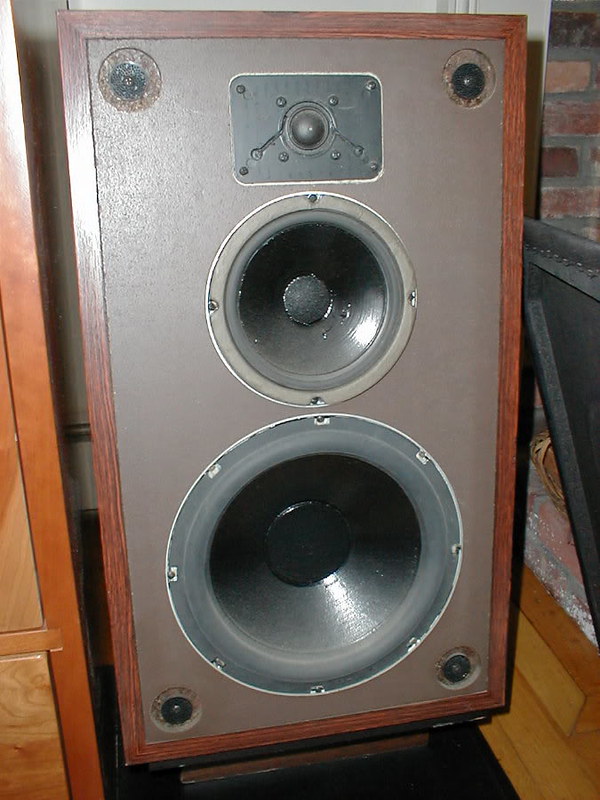Tech question: cap, inductor in woofer circuit in Monitor 7B speakers

odcics2
Posts: 371
What is the purpose of the capacitor and inductor in the mid-woofer section of the crossover?
Some of my older vintage speakers run the woofer full, letting it naturally roll off with a cap blocking the lows for the tweeter.
I'm guessing the inductor and cap control the upper and lower operating range of the mid-woofer? Anything to do with the type of crossover chosen? (12 db per octave)
Some of my older vintage speakers run the woofer full, letting it naturally roll off with a cap blocking the lows for the tweeter.
I'm guessing the inductor and cap control the upper and lower operating range of the mid-woofer? Anything to do with the type of crossover chosen? (12 db per octave)
Post edited by odcics2 on
Comments
-
Which speakers?
-
Fixed...
-
You touched on it in your last sentence. The 6.5" MW of Polk more than likely couldn't be run open like say 12" due to excursion problems.
My guess anyway. -
Not sure of the exact XO for your Monitor 7 without more information, but the schematics I see online* show a second order XO on the woofer (inductor in series, capacitor in parallel) to roll off its high frequency output.
The LF excursion of the "midwoofer" cone would be "controlled", so to speak, by the enclosure design and the passive radiator (which mimics a bass reflex port).
I am not expert on the Monitor 7 XO -- others here are.
_______________
* here's one, e.g., for one particular 7A, taken from this thread:
https://forum.polkaudio.com/discussion/148369/polk-monitor-7a-with-peerless-resistor-value
-
As mhardy noted, the mid-driver crossover is a second order low pass filter. The purpose of the 2nd order filter is to quickly cut off the output of the mid-driver above the crossover frequency. In this way, any unwelcome effects from the mid-driver operating above a certain frequency are avoided.
Some vintage speakers, like EPI, have a woofer designed to smoothly roll off above a certain frequency. The need for a crossover is much less when the woofer is specifically designed to have a electro-mechanical rolloff. Other vintage speakers sometimes run woofers wide open as a cost cutting technique.
A good explanation of crossover circuits can be found at https://www.bcae1.com/xoorder.htm -
I did forget to mention that a second order crossover provides a 12 dB per octave rolloff, in this case, above the crossover frequency. For example, if the crossover frequency is 1000 Hz, a 2000 Hz signal will pass through to the woofer with 12 dB attenuation relative to 1000 Hz, a 4000 Hz signal will be attenuated 24 dB, etc.
The above-mentioned "Burhoe module" used in the classic EPI loudspeakers was a very special case, using carefully and deliberately designed and built drivers that permitted an extremely simple crossover -- nothing more than a capacitor to protect the tweeter from low frequency signals.
This isn't a critique of the (very successful!) design of the Polk Audio Monitor Series Model 7 and its kin, but illustrates a very different approach to get to a surprisingly similar endpoint.


source: https://www.humanspeakers.com/e/epi100.htm
The Dynaco A-25 used a very similar approach to the EPI 100 (or vice versa, as I am pretty sure that the A-25 predates the EPI loudspeakers, if only by a little bit), albeit with carefully chosen "off the shelf" drivers from ScanSpeak (and also, later, SEAS) and a different mode of enclosure loading (so-called "aperiodic damping", which is sort of a leaky bass reflex port).
(borrowed internet photo of a typical pair of A-25s sans grilles)
-
I recently had a set of A25's. Rewired them. They had some caps already replaced. Sounded pretty good, open, but not over-bearing. The MW driver baskets are quality built.
I wouldn't trade my 5Bs for them. That tweeter lacks in the very upper registers. Maybe due to its size, but the mids are excellent.Don't take experimental gene therapies from known eugenicists. -
mhardy6647 wrote: »Not sure of the exact XO for your Monitor 7 without more information, but the schematics I see online* show a second order XO on the woofer (inductor in series, capacitor in parallel) to roll off its high frequency output.
The LF excursion of the "midwoofer" cone would be "controlled", so to speak, by the enclosure design and the passive radiator (which mimics a bass reflex port).
I am not expert on the Monitor 7 XO -- others here are.
_______________
* here's one, e.g., for one particular 7A, taken from this thread:
https://forum.polkaudio.com/discussion/148369/polk-monitor-7a-with-peerless-resistor-value
Extremely important to have a 100% sealed cabinet to avoid excessive mid woofer excursions!


